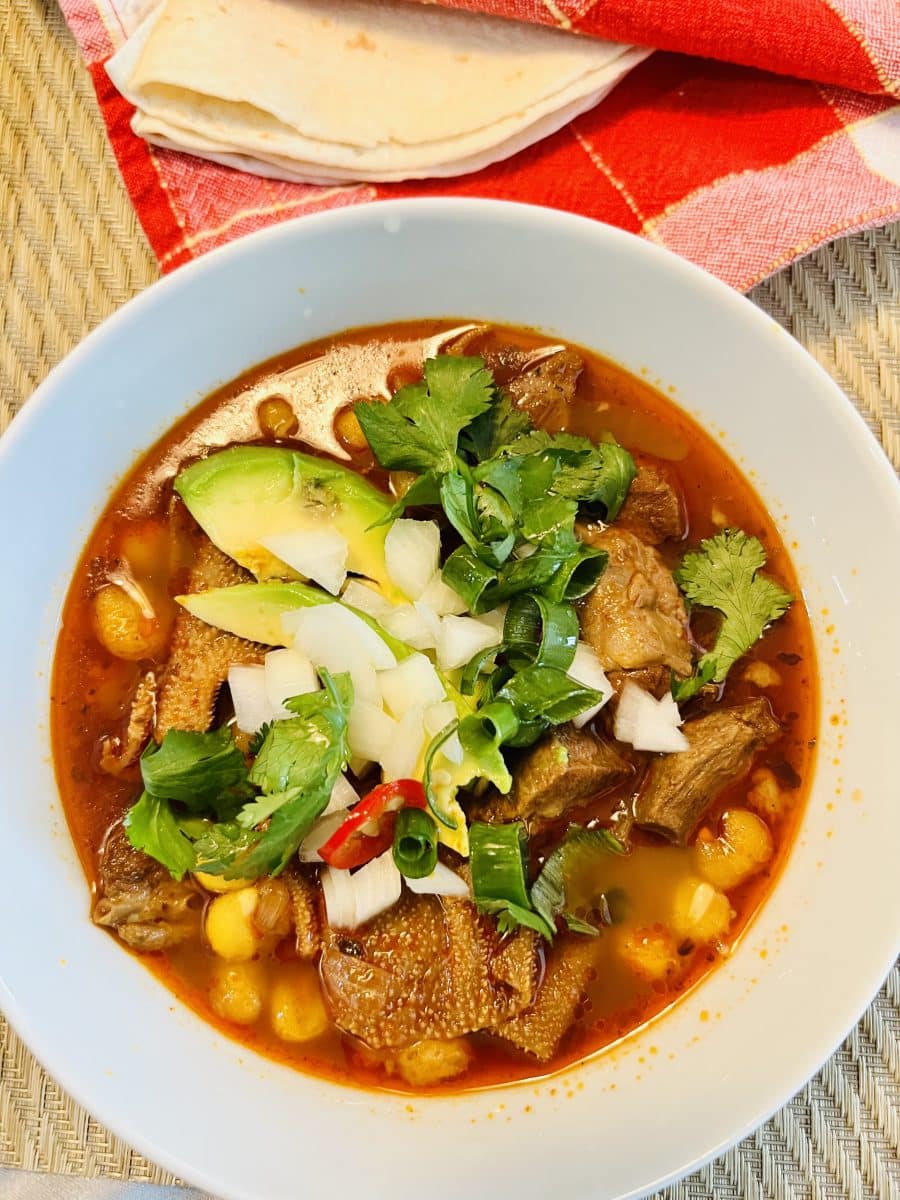Menudo rojo is a traditional Mexican dish with an appetizing character and history. Coming up with a delectable dish using throwaway or inexpensive parts (tripe and other entrails) requires years of refining the recipe and a great degree of culinary know-how.
The type of meat used depends on the availability. I never skip tripe, but I always include other types of meat such as beef tongue, heart, or tendons. Ox tail could substitute for soup bones resulting in a much thicker and almost gelatinous soup. Beef tendons are generally available in Asian/Vietnamese groceries.
The best way to extract the flavor of the meat is to cook it low and slow (simmer). The cooking times for menudo rojo are variable, depending on the meats and degree of tenderness desired, usually 2 ½ to 3 hours. The meat is cut in big chunks initially so it will not fall apart during the lengthy process of cooking.
Menudo rojo is versatile. Occasionally, menudo is served as rice topping. Soft tacos, baguette, or naan are served as sides and can be dipped in the soup.
Ingredients
For the menudo rojo:
- •1 whole beef tongue
- •454 grams (1 pound) beef tendons
- •907 grams (2 pounds) honeycombed, blanket, or book type beef tripe
- •3 pieces beef soup bones, each piece 8-10 cm (3-4 inches) long
- •Salt, as needed
- •45 ml (3 tablespoons) menudo spice mix,* or as needed
- •2 cubes beef bouillon or 30 ml (2 tablespoons) granulated beef bouillon, or as needed
- •3 bay leaves
- •1 large yellow onion, quartered
- •15 ml (1 tablespoon) dried oregano flakes, or as needed
- •5 ml (1 teaspoon) ground black pepper, or as needed
- •Three 15.5 ounce cans golden hominy
For garnishes and serving:
- •Chopped yellow onion
- •Chopped cilantro
- •Avocado slices
- •Chopped scallions (green onions)
- •Chopped red and green chilies
- •Slices of lime
- •Fresh lime juice, for sprinkling
- •Soft tacos, baguette, or naan


Preparation
- For the menudo rojo: Clean beef tongue, tendons, and tripe by cutting loose white membranes/fat on the surfaces. The tripe is usually clean, although on occasion there are clinging membranes or fat on the smoother undersurface. Wash tongue, tripe, and tendons under cold water.
In a thick-walled pot (preferably Dutch oven or cast iron), place beef tongue, pieces of bone, and tendon strips. Add water just enough to cover the bones and meat. Bring to a boil. After 10 minutes of boiling, remove the bones and tendons, leaving the tongue to boil for another 45 minutes to 1 hour. Meanwhile, rinse bone and tendon with cold water to remove anything on the surface. Set it aside.
Remove tongue from the pot and allow it to cool to the point until it can be handled. It should still be warm, making it easier to peel the outer skin with hands. Sometimes skin does not come off readily, in which case a knife could be used.*
Discard water used for boiling and clean the pot. Transfer bones to the pot and add water just enough to cover bones. Add 15 ml (1 tablespoon) salt. Bring it to a boil and keep it boiling at medium heat for 1 hour.
Slice beef tongue and tripe in big chunks, 5-8 cm (2-3 inches). Beef tendon strips can probably be left as is, as they are usually packaged as 13 cm (5 inch) strips.
After 1 hour of boiling the soup bones, add beef tongue, tripe, and tendons. Adjust water level to barely cover the meat. Bring back to a boil. Once it starts boiling, adjust heat to medium low to simmer meat. Add menudo spice mix, beef bouillon, bay leaves, onion, oregano, and black pepper. Simmer for 1 ½ hours, stirring occasionally. Adjust salt, beef bouillon, ground pepper, and menudo spice mix.
Simmer for another hour, stirring occaisonally, checking every 30 minutes for tenderness of meat and taste. Remove the lid of pot, if one desires a less soupy outcome. When adjusting the amount of fluid in the soup, take into consideration the hominy that will be added later.
Approximately 30 minutes before it is done, one can cut the meat chunks into smaller pieces with kitchen scissors while simmering. Add the hominy and simmer for another 30 minutes. Further adjust seasoning if necessary. Mix occasionally. When the meats are tender, discard the soup bones. Serve menudo hot, topped with garnishes and squeezed lime juice.
*There are many ways of skinning beef tongue. Check the internet to see whatever works for you.

